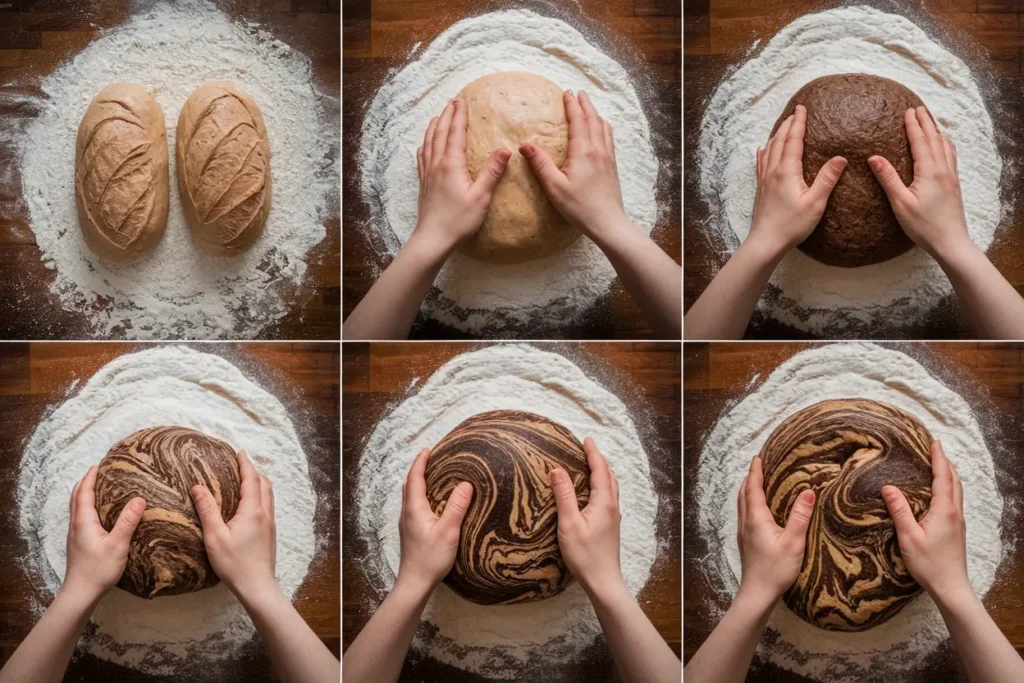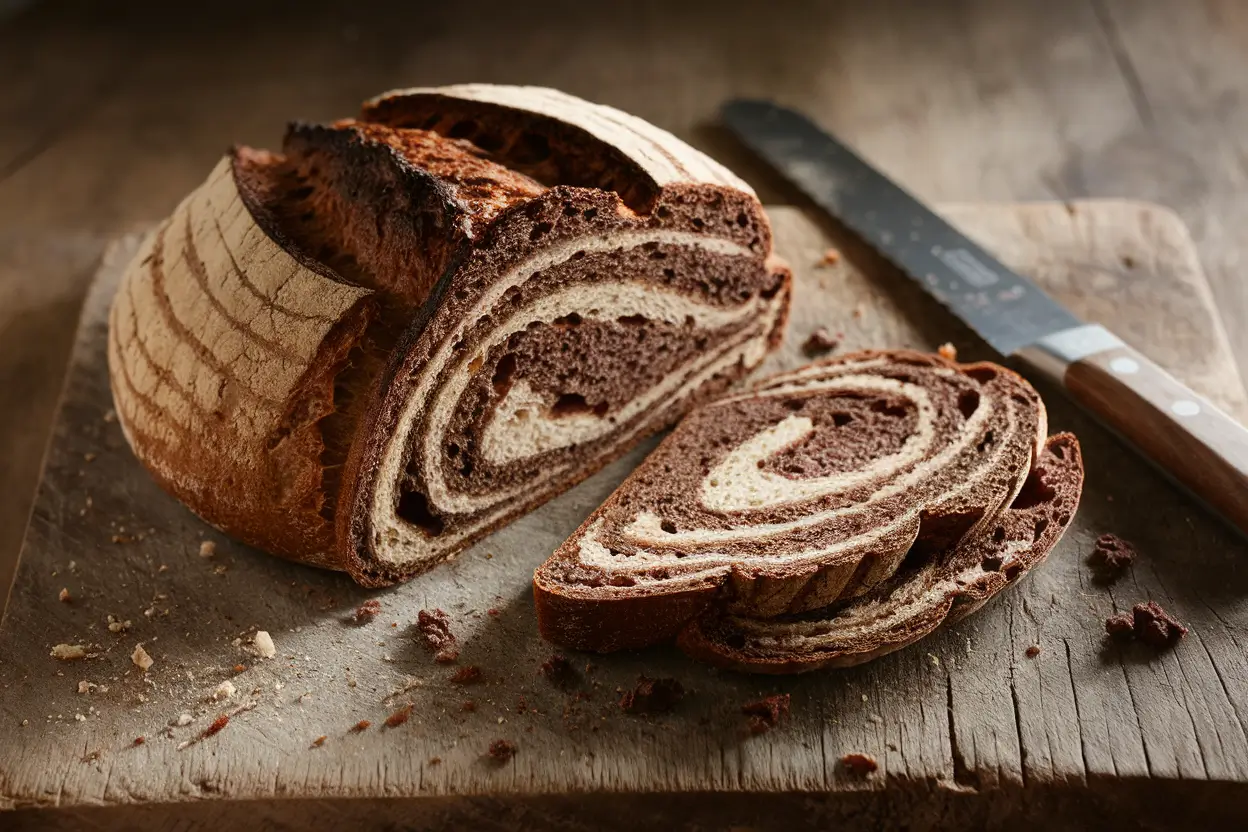Introduction
Marble rye bread is a culinary treasure loved for its eye-catching swirl of light and dark rye dough. It’s more than just bread—it’s a staple in delis, a versatile base for gourmet sandwiches, and a fascinating piece of baking history. In this article, we’ll unravel everything about marble rye: its origins, ingredients, baking secrets, health benefits, and culinary uses. Whether you’re a seasoned baker or a curious foodie, this guide has something for you. Let’s begin our journey with the basics.
Understanding Marble Rye Bread
What Is Marble Rye Bread?
This type of rye bread stands out for its eye-catching marbled appearance, created by combining light and dark rye doughs. The swirling pattern, achieved during baking, adds both visual charm and enhanced flavor. It offers a delightful complexity, blending the tangy essence of rye with the aromatic richness of caraway seeds.
This loaf is cherished not only for its unique look but also for its versatility. Whether paired with hearty soups, transformed into gourmet sandwiches, or toasted and served with butter, it remains a favorite among bread lovers. Originating from Eastern European culinary traditions, it has since become a cornerstone of Jewish-American cuisine.
Key Characteristics of Marble Rye
What sets marble rye apart is its balance between taste and texture.
- Flavor Profile:
- The light rye dough contributes a mild sweetness.
- The dark rye adds depth with earthy undertones, creating a well-rounded taste.
- Ingredients:
- Often made with rye flour, wheat flour, and caraway seeds.
- The caraway seeds add a licorice-like aroma that complements the rye’s tangy notes.
- Texture and Appearance:
- Features a tender crumb and slightly chewy crust.
- The marbled effect creates not only visual appeal but also a nuanced flavor experience with each bite.
Historical Background of Marble Rye
Rye bread traces its roots back to Europe, where rye flour was a staple crop, thriving in colder climates unsuitable for wheat. Rye bread was a dietary mainstay across Eastern and Northern Europe due to its hardy nature and nutrient-rich profile.
Marble Rye in the United States
- Marble rye is believed to have been introduced by Eastern European Jewish bakers who immigrated to the U.S. in the late 19th and early 20th centuries.
- Combining light and dark rye doughs was likely an adaptation to appeal to American palates while preserving the traditional essence of rye bread.
Influence of Decorative Baking
- The marbling technique may have been inspired by European decorative baking traditions that combined doughs of different colors and flavors.
- This innovative method turned a staple into an art form, making marble rye a standout in bakeries and delis.
Today, marble rye is celebrated as a blend of cultural heritage and culinary artistry, gracing the shelves of bakeries worldwide.
Why Is Marble Rye So Popular?
The enduring popularity of marble rye bread lies in its:
- Versatility: It complements both savory and sweet toppings.
- Flavor Variety: Offers a balance between tangy rye and subtle sweetness.
- Visual Appeal: Its marbled pattern makes it a centerpiece on any table.
- Iconic Dishes: Marble rye is the foundation of beloved recipes like the Reuben sandwich, further cementing its place in culinary history.
Whether enjoyed in a sandwich, toasted with butter, or paired with soup, marble rye remains a staple for bread lovers everywhere.
Composition and Varieties
Ingredients of Marble Rye
The magic of marble rye bread lies in its ingredients, which create its signature swirl and rich flavor. A classic marble rye recipe includes both light rye dough and dark rye dough, with each bringing distinct flavors and textures. Let’s break down the essential components that make this bread so unique:
Rye Flour
Rye flour is the foundation of marble rye, lending the bread its characteristic earthiness. Unlike wheat flour, rye flour contains less gluten, resulting in a denser, chewier texture. Depending on the recipe, bakers may use a combination of light and dark rye flours, with the latter contributing a deeper, more robust flavor.
Wheat Flour
To balance the density of rye flour, wheat flour is typically added to the dough. The gluten in wheat flour improves the bread’s elasticity and structure, allowing the dough to rise properly and achieve the perfect crumb.
Caraway Seeds
Caraway seeds are a defining ingredient in many rye bread recipes, adding a distinctive, slightly licorice-like flavor. These seeds are often sprinkled into the dough or on top of the loaf for added aroma and texture. For those who prefer a milder flavor, this ingredient can be omitted without compromising the bread’s quality.
Exploring Types of Rye Bread
this rye-based bread is just one of many varieties of rye bread. Each type has its own flavor profile, texture, and culinary applications. Let’s dive deeper into the world of rye bread:
Light Rye
Light rye bread is made with finely milled rye flour, resulting in a lighter color and milder flavor. It’s an excellent choice for those new to rye bread or seeking a subtler taste profile.
Dark Rye
Dark rye bread is crafted from whole rye flour or a blend that includes molasses or cocoa powder for added color and flavor. This type is richer and denser, making it a favorite for hearty sandwiches.
Pumpernickel
Pumpernickel is the darkest and most robust of the rye bread varieties. Traditionally made with coarsely ground rye and slow-baked for hours, it boasts a deeply caramelized flavor. Although distinct from marble rye, it often inspires its darker dough.
What Makes Marble Rye Stand Out?
The blend of light and dark doughs in marble rye strikes a balance between the mild sweetness of light rye and the bold, earthy tones of dark rye. This combination not only enhances the bread’s flavor but also its versatility, making it a staple for sandwiches and other creative culinary uses.
By breaking down the ingredients and exploring the types of rye bread, it’s clear that marble rye bread offers a unique combination of taste, texture, and tradition.
Preparation and Baking Techniques
How to Make Marble Rye at Home
Creating this rye-based bread at home is a rewarding experience that combines creativity with classic baking techniques. While the process may seem intricate, it’s straightforward when broken into manageable steps. You’ll prepare two doughs—light rye and dark rye—then combine them to form the signature marbled swirl. Here’s a step-by-step guide to help you bake this stunning and flavorful bread.
Preparing the Dough
The foundation of marble rye lies in its two distinct doughs. Begin by gathering the following ingredients for each dough:
Light Rye Dough
- 1 ½ cups rye flour
- 1 cup bread flour (or all-purpose flour)
- 1 teaspoon salt
- 1 tablespoon sugar
- 1 ¼ teaspoons active dry yeast
- ¾ cup warm water (110°F)
- 1 tablespoon vegetable oil
Dark Rye Dough (same as above, with these additions):
- 2 tablespoons unsweetened cocoa powder (for color and depth)
- 1 tablespoon molasses (for sweetness and a richer hue)
Mix and Knead
- Mix the dry ingredients for each dough in separate bowls.
- Gradually add the wet ingredients, including warm water and oil, until a rough dough forms.
- Knead the dough on a floured surface for 8–10 minutes until it becomes smooth and elastic.
Let the Dough Rest
Place each dough in a greased bowl, covered with plastic wrap or a damp towel. Let it rise in a warm place for about 1–2 hours or until it doubles in size.
Creating the Marbled Effect

The artistry of marble rye bread lies in its marbling. This step brings out the bread’s visual and flavor appeal.
Roll and Layer
- Punch down the risen doughs and roll each one into a rectangle (about 12 x 8 inches).
- Place the dark rye dough on top of the light rye dough. For a more intricate pattern, alternate layers of light and dark doughs.
Roll and Twist
- Starting from the shorter end, roll the doughs tightly into a log.
- For a dramatic marbled effect, slice the log lengthwise into two halves and twist them together.
- Pinch the ends to seal the dough, ensuring the pattern stays intact during baking.
Shape and Rise
Shape the twisted dough into a loaf and place it in a greased loaf pan or form it into a boule (round loaf). Cover loosely and let it rise again for 30–45 minutes.
Baking Marble Rye
Now it’s time to bake your marbled creation!
Preheat the Oven
Set your oven to 375°F (190°C). To create steam, place an empty baking sheet on the bottom rack. This step ensures a crisp crust.
Score the Loaf
Use a sharp knife or bread lame to make shallow slashes on the surface. This allows the loaf to expand evenly as it bakes.
Bake the Bread
Bake the loaf for 30–40 minutes, rotating the pan halfway through for even browning. The bread is ready when it sounds hollow when tapped on the bottom.
Cool Completely
Allow the loaf to cool on a wire rack for at least 1 hour before slicing. Cutting too early can result in a gummy texture.
Pro Tips for Perfect Marble Rye
- Experiment with Ratios: Adjust the amount of dark and light dough to create unique marbling patterns.
- Add Flavor Enhancements: Incorporate garlic powder or onion flakes for an extra savory touch.
- Proper Storage: Slice and freeze leftovers in airtight bags for quick, ready-to-toast portions.
By following these steps, you’ll master the art of making this rye-based bread. Not only will you enjoy the process, but you’ll also create a visually stunning and delicious loaf that’s perfect for any meal!
Nutritional Profile and Health Considerations
Nutritional Value of Marble Rye
this rye-based bread offers a balance of flavor and nutrition. It’s lower in calories than white bread and richer in fiber, thanks to the rye flour. The combination of rye and wheat provides essential nutrients like B vitamins, magnesium, and iron.
Health Benefits
- Digestive Health: High fiber content supports gut health.
- Low Glycemic Index: Rye’s slower digestion helps maintain steady blood sugar levels.
- Heart-Friendly: Rye bread may lower cholesterol levels and promote heart health.
Potential Allergens
While this rye-based bread is a healthy choice, it contains gluten, making it unsuitable for those with celiac disease or gluten intolerance.
Culinary Uses and Pairings
Popular Dishes Featuring Marble Rye
this rye-based bread shines in many classic dishes, elevating their flavor and presentation. Here are some culinary highlights:
Reuben Sandwich
Arguably the most famous use of marble rye, the Reuben sandwich combines corned beef, Swiss cheese, sauerkraut, and dressing, creating a symphony of flavors that pairs perfectly with the bread’s tangy notes.
Pastrami on Rye
This deli favorite features layers of pastrami piled high between slices of marble rye, complemented by spicy mustard or pickles.
Smørrebrød
A Danish open-faced sandwich, smørrebrød often uses marble rye as the base, topped with smoked salmon, pickled herring, or eggs for a visually stunning and delicious dish.
Best Pairings with Marble Rye
Marble rye is incredibly versatile and pairs well with a variety of foods:
- Cheeses: Sharp cheddar or creamy Havarti.
- Meats: Roast beef, turkey, or smoked salmon.
- Spreads and Condiments: Butter, hummus, or a dollop of tzatziki.
Frequently Asked Questions (FAQs)
What is the difference between rye and marble rye?
Rye bread is made entirely with rye flour, while this rye-based features a mix of light and dark rye doughs, creating a distinctive swirl and a more complex flavor.
What flavor is marble rye?
this rye-based bread combines the tangy earthiness of rye with the mild sweetness of light rye dough, often enhanced by caraway seeds for a licorice-like kick.
Is marble rye good for you?
Yes! With its high fiber content and lower glycemic index, this rye-based bread supports digestion and helps maintain steady energy levels.
What is the dark part of marble rye?
The dark dough in marble rye gets its color and flavor from molasses or cocoa powder, which also add a subtle sweetness.
Conclusion
this rye-based bread is a timeless favorite that combines beauty, flavor, and versatility. Its unique marbled appearance, robust nutritional benefits, and culinary flexibility make it a staple for bread lovers and chefs alike. Whether enjoyed as a sandwich base, toasted snack, or creative recipe ingredient, marble rye continues to capture the hearts and palates of many. Explore its history, bake it at home, and savor the art of marble rye!

